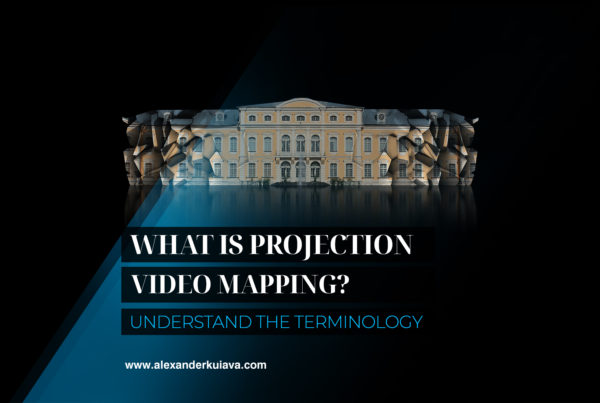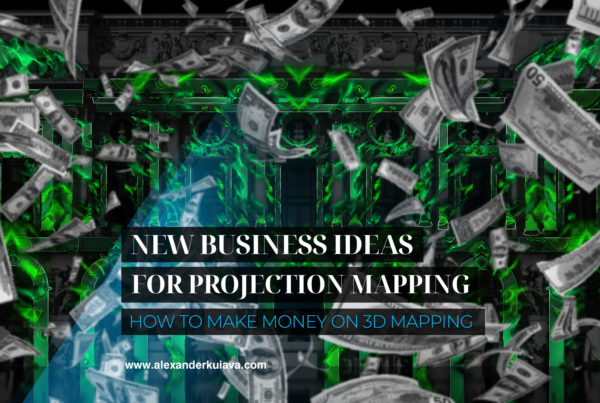In this article, we will list all the types and forms of video mapping projection we know, and also try to think a little about the methods of application. To understand the possible applications of video mapping, you need to understand the term Video Mapping itself. In our last article, “What is video mapping”, we analyzed this. To sum up, the video projection is impossible without the object of projection. That means, the light waves that the video projector emits must fall on some surface to get a visible picture. If a video projection could be fixed in the air, it would be called a “hologram”, but technology is still only heading to this. Let’s go back to video mapping. Since we need a specific object, this means that the application of video mapping will be limited by the nature of the object.
Now let’s think – what can we project light and visuals on? In fact, almost everything. Any object can become a canvas for your performance or video show. Today, there are already many familiar objects/surfaces on which video projections are created. Some are already used for several years, others are just entering the trends, and not even in all countries. And we are sure that there are many other opportunities that are not yet opened. Therefore, let’s firstly list the real, already known areas of application of video mapping and try to predict possible options for new “trends”.
Types of projection video mapping by the projection object
Architectural
Video mapping projections on the facade of buildings – the most common version of 3d mapping projections, because of which most people have learned what video mapping is and what it looks like. This format is interesting because it is possible with the help of specially created 3d graphics, animation to create a parallel world on the building itself, to show its depth, using a thematic visual series. For this purpose, to change the geometry of the building, we recommend our partners to use Video Mapping Loops – video footage with a 3d effect. But the most important thing that makes the facade of the house not just a wall for video projection, but a real work of art is the architectural elements. Columns, arches, pilasters, balustrades, windows, cornices, etc. All this must be emphasized, highlighted. Open the potential of these motionless shapes and show a parallel world where they can move. For such tasks, we have developed many animations of these facade elements in a variety of thematic styles and forms of animation: fire, water, smoke, destruction, cyberpunk, animation of the growth of tree branches, flowering, and many others. More information can be found here. Architectural video mapping itself can have different presentation formats. But in most cases, it is used only as a one-time video show dedicated to some holiday or event. We see the use of architectural video mapping projections more in a permanent way. As a permanent element of the exterior or interior. In our article, “Business Ideas for Mapping shows”, we described this more detail.
Object
The next type, the format of video mapping in its demand is Object Video Mapping. The projection object is much smaller than the building. It can be any interesting geometric shape or real object: cars, planes, yacht sails, mannequins, statues, sculptures, and even a person and human body parts. Also, very often, stage decorations, decorations for clubs, exhibitions, for a DJ or an artist are created from wood, cardboard, metal, plastic or fabric. Since such items are mobile, mapping on them can also be easily cataloged as object mapping. The most common object mapping in our time is mapping to cars, cubes and boxes. If the first 100% of cases are used in the format of a show, as a representation of a new car model, then projections on cubes are almost always either at events, or as art video installations. The company FrontFX (ex. LIME ART GROUP) – “came up” with a new version of object mapping, and it is a video projection on a wedding cake. This mapping can be used as a show performance or as a permanent installation for all the days of the wedding until the cake is eaten 🙂
Interior
Projection light by its nature, by the way it is reflected from the object, seems to look softer, more gentle, compared to LED video screen and its light. Those who have a video projector instead of a TV at home will understand me. Still, if we talk about the topic, the use of video mapping projections in interiors is very popular in expensive locations, clubs, event halls, restaurants, exhibition centers and galleries. Interior mapping can be called such if you use at least 3 projectors and can simultaneously cover at least 50-60% of your interior area, and not different scattered pieces of projections, but combined video mapping with marking of different areas and objects in the interior. It often happens that for interior and sometimes panoramic mapping, content of the desired resolution is used, for example, 5760 x 1080, that is 3 times Full HD in width. The beauty of interior mapping is that the projection light is perceived a little differently in the interior environment, and with the right video content, you can achieve the visual effect of high cost, comfort and even coziness, a certain “warmth”. There are also options when 100% of the interior is covered, this is called immersive video mapping and this is often used by artists for exhibitions in galleries and museums. In theory, this can be separated into additional form, the immersive category, but we decided to leave it here.
Fulldome
If you’ve ever been in a planetarium, you know what it’s all about. The projection created with 4 or more video projectors is superimposed on the curved plane of the sphere – on the dome, in other words. This is a very expensive toy, both from the technical side, from content production side, and the organization of the location, a geodetic structure. It happens that in such a building, an additional projection is also made on the floor. Here we can say that this is immersive mapping. To create a fulldome video mapping, you need special software and video content in a resolution of at least 4K, and even better – 8K resolution, not to mention good and expensive projectors. By the way, we have specially developed video footage in 4K resolution for fulldome 3d mapping, which do not cost as a spaceship and are distributed under a Royalty-Free license.
Landscape
Video mapping on natural objects, trees, mountains, hills, rocks, etc. Since all the listed objects have many elements in them, this means that it is possible to make needed content and design every necessary element, every branch of the tree. The video projection looks very nice on the crowns of trees with large wide leaves, such as maple or chestnut. Due to the fact that the leaves are at different distances from each other, the projected light creates numerous shadows, and when broadcasting, for example, a photo or video of a person’s face close-up, the face will become voluminous due to the crown and textured due to the leaves. Differently, but no less beautiful in winter, the ski areas for freestyle skiing and the illuminated rocks look. In any case, if we talk about mapping to rocks, we need even more expensive and powerful projectors than when projecting to architecture.
We have described 5 types of video mapping projections that can be distinguished as independent types, categories. But there are also some interesting video performances that can hardly be called video mapping, but because of their visual form, they also fall under the term projection art.
Holographic projections on transparent screens
Everyone really wants performances like science fiction movies, the messages of Princess Leia from Star Wars, dystopian Cyberpunk 2077 exteriors or the Altered Carbon TV series techs. But unfortunately, the technologies from these films are not yet available. Everything that concerns dynamic video content or animation and has the prefix Hologram, in fact, is not so. It is more correct to say pseudo hologram. But again, for simplicity and marketing reasons, everyone uses the word hologram.… I think many of you have seen the Tupac Shakur concert, or the relatively recent performances of the world’s DJs, where 3d objects spin in the air in front of them, roughly resembling a hologram. This effect is achieved with 3 components. A special transparent film (screen), specially created video content, 3d animation on a black (transparent) background, and a regular projector that lights on the film, at a specially set angle of 30-45 degrees. The film captures the content at this angle, and people who look at the artist, stand in front of the film, the film itself is not visible, but only the projected video content. We have previously described how video projectors work, and that such equipment does not show black color/light. Therefore, a black background on a transparent screen will not be displayed. But the illusion of the volume of the object will only be preserved when you look directly at it and do not move. But if you move aside and look at the screen from the side, you only will see a plane. In addition, such projections on a transparent screen can not be called mapping, because there is simply nothing to map. You project 1 picture on 1 screen. That’s it.
Water Projections – Water Walls
Here, the principle is the same as with transparent screens. The projection lies on the water plane of the fountain, which is placed perpendicular to the tank under it. But in this case, due to the flow of water, there is a texture of water, a little foam. When watching such a performance at night from the shore, we will not always see the fountain itself, and it will seem that something is “dancing” on the water. Naturally, the more powerful the projector and the larger the fountain, the larger the projection will be. In the same way, we will not call it mapping, because we design one image on one space. In any case, it also looks very beautiful and in demand. If you need dancing ballerinas on a black or transparent background for such video shows, you can contact our partners on the Green Screen Stock website.
Projection on the smoke
By the same analogy, there can be a projection on the smoke. All the same principles and methods that work for transparent screens and water projections will work here.
Types of projection video mapping by field of application
Each of these views can be projected onto the planes, objects described above, i.e. buildings, interiors, objects, cars, decor, and so on.
Advertising
The use of video projections and video mapping in advertising is not new. Global respected brands use video mapping as the show format to present new products, clothing collections, or a new car model. There are a lot of examples on YouTube. But rarely video mapping used as a permanent installation for advertising. Maximum for a month. For example, in Vienna, Austria, in the Museum Quarter, at the Leopold Museum, a beautiful Christmas video projection installation is created every holiday. Or in Kiev, Ukraine, a thematic video series is projected on the facade of a local confectionery factory during the New Year holidays.
Decorative
Visual design of events, locations, bars, restaurants, and investment halls. Such video projections look very beautiful at weddings. Recently, more and more restaurants and clubs are moving to the projection in the interior. After all, it is much easier to change the digital image for a thematic event than to change the entire decor of the club. And again, if you use video mapping in the city on a permanent basis and thus decorate several buildings on the same street, then we can say with confidence that a new direction in urban design may appear.
Entertainment
This type of video projection mapping shows can often be seen at various festivals, concerts, opening ceremonies, and similar events. By and large, almost all video mapping is a bit entertaining. The question here is how it is used and for what purposes? Do we need to decorate the location, or advertise the product? Or cause people to applaud and shout “Wow”.
Educational
Educational and entertaining. You can see it in galleries and museums. There are business artists who create entire installations for contemporary art museums, reviving old paintings and projecting them completely into the exhibition space.
There are 2 more options for video mapping based on the development method.
Standard-Video Mapping
When the project is programmed in advance, 3d graphics, animation, visual content and script are prepared. Such video mapping works very well, and through it is possible to show very effectively the desired message of the customer, his story, idea. The performance can be played in a couple of minutes, or can last for several hours, turning into a real video mapping movie.
Interactive 3D Mapping
This is a new and effective offshoot of projection design towards short effects. Interactive video mapping appeared with the development of software that allows you to create interactive installations. When it is no longer enough for the viewer to just watch and be inspired, but also to interact. In this sense, as such, the plot is not important here, but the function, the quick effect, the action and the result are important. So with human movements, or sound, you can animate the projection. Nothing new, though. You pressed the button – a function worked, waved your hand – a bird flew out. 🙂
It’s up to you to decide which type of video mapping to work with more. We want to say that absolutely every area of video mapping, whether it is architectural for brands, or interior for wedding decorations – there are popular niches. It’s like cooking. You can learn how to make good salads, and cook them both for company directors, and for show business stars, and for workers on the factory of materials for the space industry… it’s up to you.
Sincerely,
Alexander Kuiava, a media artist, content producer,
CEO of Austrian video production studio LIME ART GROUP
and co-founder of Nektar Digital production group content.
The author of my own techniques for developing video projection
shows and a teacher at the Frontskill School of Media Art.
Online entrepreneur and social investor. VJ in retirement.




